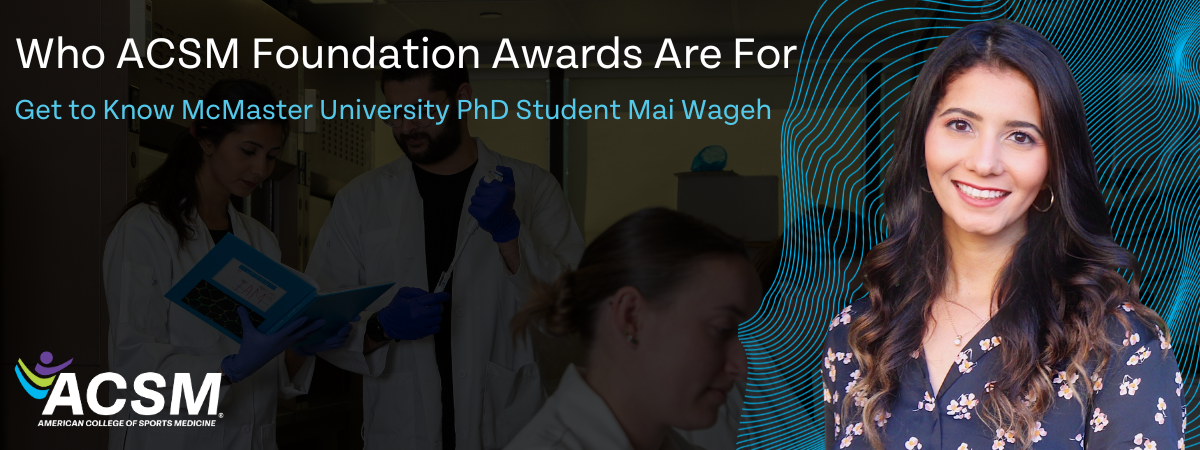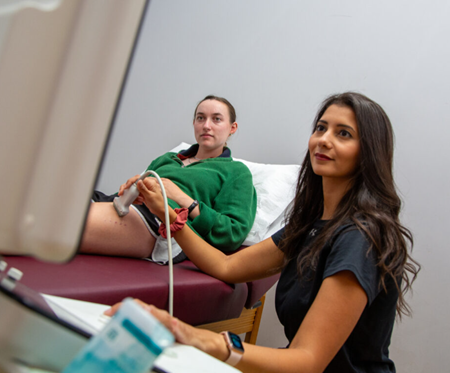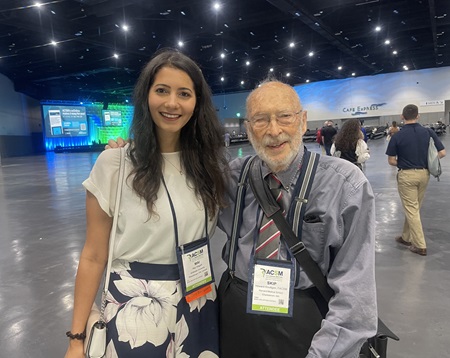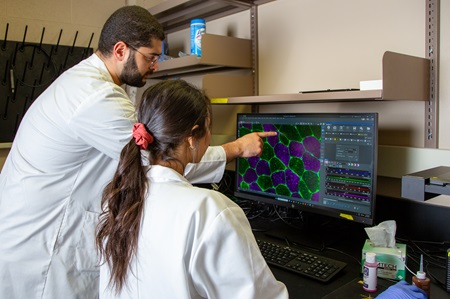
If you’ve ever wondered about the impact of the ACSM Foundation, look no further than how it’s supported the work of PhD candidate Mai Wageh.
 Based at McMaster University’s Exercise Metabolism Research Group, Wageh studies sex-based differences in biological processes — particularly in relation to exercise adaptation and sports performance — and her work has taken her from San Diego to Stellenbosch, South Africa, in no small part due to the generosity of the ACSM Foundation’s donors.
Based at McMaster University’s Exercise Metabolism Research Group, Wageh studies sex-based differences in biological processes — particularly in relation to exercise adaptation and sports performance — and her work has taken her from San Diego to Stellenbosch, South Africa, in no small part due to the generosity of the ACSM Foundation’s donors.
An ACSM student member, Wageh has so far received the Howard G. “Skip” Knuttgen International Scholar Award (2022), the SILC Basic Science Award (2024) and the Jack Wilmore Legacy Travel Award (also 2024), the first of which assisted her in two-month research exchange at Stellenbosch University.
(For the purposes of promoting international scientific dialogue, Skip’s award provides air fare, a lodging stipend and medical insurance for U.S. or Canadian researchers interested in teaming up with ACSM experts outside the U.S., and vice versa.)
At Stellenbosch, Wageh worked with ACSM leading light Kathy Myburgh, the world’s preeminent authority on extracellular vesicles. “EVs” are essentially miniscule protein envelopes containing genetic information and other materials that cells release into the bloodstream as a means of communication. Or at least that’s one of their potential functions. The field is really quite new.
Myburgh, an ACSM fellow, 2023 Citation Award winner and expert in muscle damage and repair, has lately focused on EVs’ role in muscle adaptation. And it was from her and her team that Wageh learned the type of progressive and precision centrifuge work necessary to isolate EVs from a serum sample, a component technique of the larger process of nanoparticle tracking analysis.
For her part of the research exchange, Wageh walked Myburgh’s team — the Muscle Research Group, or “MRG” — through some of the more advanced histological staining techniques she’d already picked up at McMaster:
“I had worked up a stain prior to going there that they specifically needed,” Wageh says. “It was to look at CD11b, a pan-leucocyte marker. And I paired that with Pax7, a marker of satellite cells, with myeloperoxidase, and with Hoescht (a nucleic marker), and made this little cocktail that we could replicate over there. It was super fun. I got to do all the science and got to make a whole bunch of new friends who to this day I’m still I touch with and bounce ideas off of.”
An avid exerciser, Wageh was introduced to CrossFit by a fellow researcher in South Africa, enjoying the camaraderie of the Box while she was outside the lab.
As for Skip Knuttgen, the benefactor of the award that sent her to South Africa, Wageh says, “Skip is such a wonderful, bright human being. Even until today we’re still pen pals.”
Wageh’s PhD research focuses on how differing hormonal profiles affect a subject’s response to exercise. Initially, she performed the work in vitro, largely in response to the COVID-19-related shutdowns, growing muscle tissue in petri dishes and applying hormones to the culture. In particular, she focused on differing proportions of estrogen and progesterone so as to model the different phases of the menstrual cycle.
 “Then I took birth control hormones of four different generations of birth control, combined those, and looked at satellite cell proliferation, differentiation, migration and the expression of myogenic proteins,” she says.
“Then I took birth control hormones of four different generations of birth control, combined those, and looked at satellite cell proliferation, differentiation, migration and the expression of myogenic proteins,” she says.
She also used a C-pace machine — a device that applies an electrical shock to lab-grown muscle cells so as to mimic the contractions that take place during exercise — to usher the cells into the realm of truly damaging stress, later studying the downstream effects. This work culminated in the publication “Effect of Endogenous and Synthetic Sex Hormones on Myoblast Function Following Electrical Stimulation” in Medicine and Science in Sports and Exercise® (MSSE) in September 2023.
As COVID restrictions began to lift, Wageh was able to transition her research to human subjects and eventually ran what she suspects might be the most comprehensive study of sex-based differences in muscle damage yet performed. The study design involved putting a pool of 15 male and 15 female subjects on a Biodex machine — a complex seat, sensor and computer affair for measuring exertional and related output — and having them complete 300 eccentric kicks on each of their legs. Prior to the exercise, the team took biopsies and blood samples, performed ultrasounds and had the participants answer questionnaires about subjective pain and soreness. The team harvested the same data after the subjects’ exercise bout and again at 5, 24, 48, 72, 96 and 120 hours post exercise, respectively.
“And then that transitioned into my third PhD study,” Wageh says, “where we then did the same protocol, but we looked at normally cycling females and then females who were on birth control. Nobody knows this, but (birth control) has substantial effects on your cardiovascular system, your muscle system, your fuel oxidation.”
Wageh notes that cardiovascular researchers are way ahead of the sports medicine and exercise science community in the study of birth control’s effects, perhaps because the first and second generations of birth control in particular were quite detrimental to endothelial function.
“The thing about the first two generations is that they’re more androgenic, so they almost shift the female into more of a male phenotype,” Wageh says, “which for the female body is not a good thing. It shifts how the body works and puts a more stressful load in it.”
 Wageh attended her first ACSM annual meeting in Minnesota in 2018 and was impressed by the opportunities on offer. She has tried to attend every subsequent meeting, presenting posters in 2018, 2020, 2022, 2023 and 2024 and was helped to do so in that final year by both the SILC and Wilmore travel awards.
Wageh attended her first ACSM annual meeting in Minnesota in 2018 and was impressed by the opportunities on offer. She has tried to attend every subsequent meeting, presenting posters in 2018, 2020, 2022, 2023 and 2024 and was helped to do so in that final year by both the SILC and Wilmore travel awards.
The Jack Wilmore Legacy Travel Award was founded in honor of ACSM’s 22nd president, Jack H. Wilmore, PhD, FACSM, and assists with doctoral students’ and postdoctoral fellows’ travel expenses to ACSM meetings. The Science Integration & Leadership Committee (SILC) Basic Science Award also contributes to students’ travel expenses and is conferred based on excellence in research.
“I think one of the things people don’t realize until they go to their first conference is how helpful, useful, enriching and mind expanding it is — because of the people you meet and by being able to present your work,” Wageh says.
At the 2024 ACSM Annual Meeting in Boston, Wageh presented the poster “Sex-Based Differences Following Eccentric Exercise-Induced Muscle Damage” — the culmination of the second research study reference above — thanks in no small part to her foundation-administered awards. But it wasn’t merely the facilitation of her poster presentation that mattered to Wageh:
“The funding gave me the time not to just put into my research but my mentorship efforts,” she says. “And that’s a huge part of my career — bringing people into research.”
Wageh prides herself on being able to introduce people in her orbit to one another and help younger researchers find their way. One student she connected with at an annual meeting became a close friend in academia, and the two bounced ideas back and forth on Pax7 imaging for a year, ultimately leading to his presentation of that work at ACSM in 2024.
Not coincidentally, Wageh plans to apply for ACSM’s Leadership and Diversity Training Program (LDTP), which “exists to mentor and retain minority members by offering three different levels that require ACSM membership, involvement in ACSM meetings (regional and national) and committees, and pursuit of ACSM professional presentations, publications and fellowship.”
The program also assists student members through all the steps necessary to become ACSM fellows. In that case, Wageh would be the mentee, of course. But she values the nature of such relationships and connections.
 Besides a potential stint in the LDTP, Wageh isn’t yet sure what the future holds. She’s considering postdoc positions in South Africa, the US and Canada.
Besides a potential stint in the LDTP, Wageh isn’t yet sure what the future holds. She’s considering postdoc positions in South Africa, the US and Canada.
But no matter what, it’s the lab where she really feels at home.
“I live and breathe lab work,” she says. Ninety-nine percent of the time you’ll find me kicking around at the lab bench, trying a new experiment or testing a new hypothesis, and that’s not something I see myself letting go of.”
The ACSM Foundation stewards 20+ awards that boost careers, further scientific exploration, expand educational outreach and more, conferring over $100,000 annually upon researchers and scholars.
If you’d like to join in that mission, the foundation is particularly interested in boosting the Jack Wilmore Memorial Fund (which helped send Wageh to the 2024 annual meeting) and the Steven Horvath Memorial Fund, both supporting researchers and educators, as well as the Lisa Krivickas Memorial Fund, which supports clinicians.
Visit the ACSM Foundation page to learn more.
Story by Joe Sherlock
Images courtesy of Mai Wageh
Published December 2024
6510 Telecom Dr.
Suite 200
Indianapolis, IN 46278
317-637-9200
317-634-7817
ACSM’s National Center hours are 8 a.m. to 5 p.m. ET Monday through Friday.
© ACSM. All Rights Reserved.